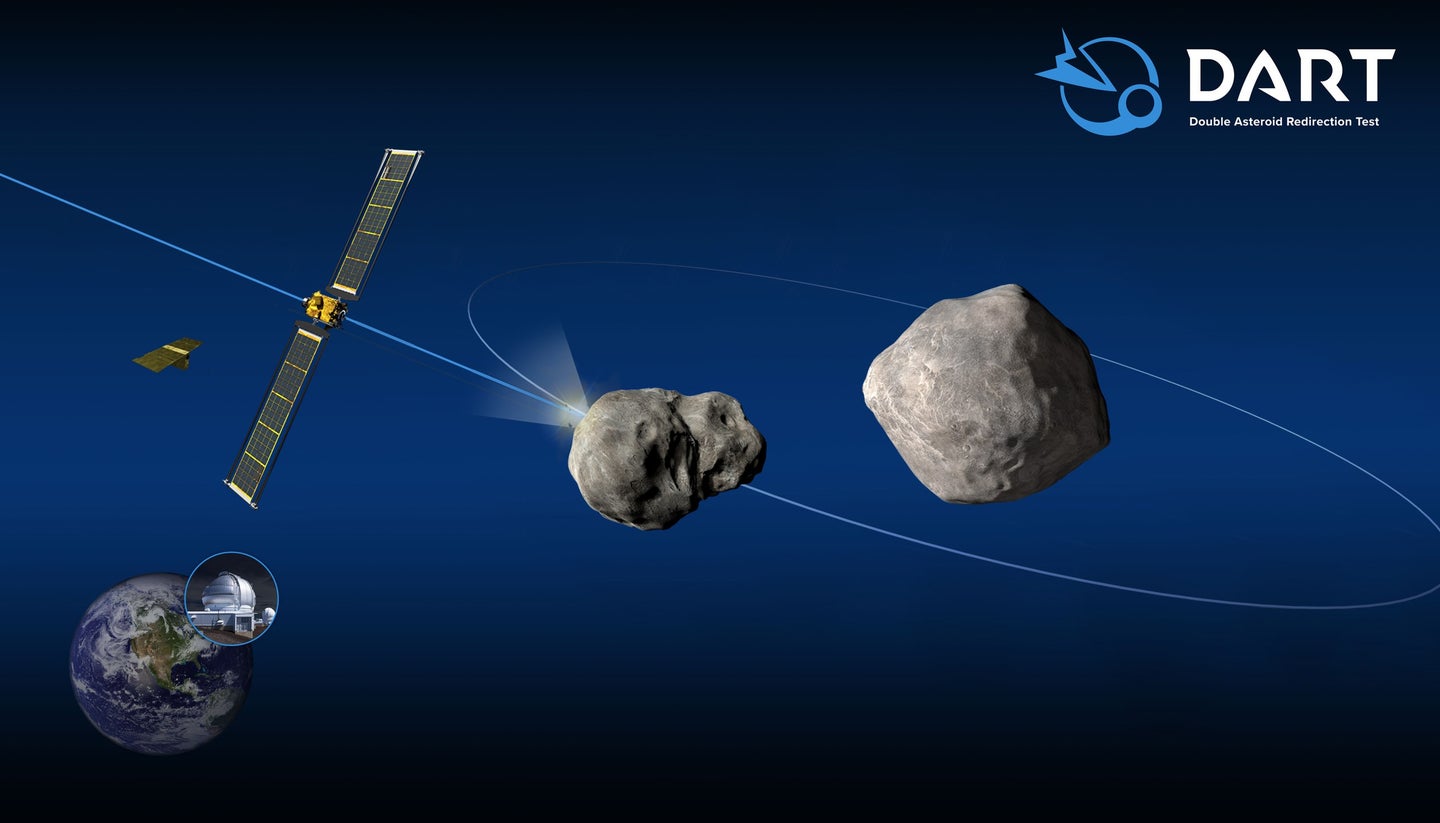
Tonight, the world will be watching to see if redirecting the asteroid Dimorphos using a spacecraft the size of a small car will be a smashing success.
As a dry run for future astroid forecasting and deflection, the spacecraft named Double Asteroid Redirection Test (or DART) will slam itself into an asteroid at 14,000 mph tonight around 7 million miles away from earth. NASA telescopes and cameras will watch the crash, but it will take days or possibly weeks to find out if DART actually changed the orbit of the rock. “This is stuff of science-fiction books and really corny episodes of ‘StarTrek’ from when I was a kid, and now it’s real,” said NASA program scientist Tom Statler last week at a media briefing.
The $325 million planetary defense test began with DART’s launch in November 2021. The goal is for the spacecraft to nudge the 525 foot-wide asteroid into a tighter orbit around its parent rock (Didymos, the Greek word for “twin”). Dimorphos is a smaller companion to the 2,500 foot-wide Didymos is a moonlet orbiting the larger rock at at less than a mile apart. The two make up a binary asteroid system – meaning that the the small moon (Dimorphos) orbits the larger body (Didymos). This pair of asteroids was partially selected because there is absolutely zero chance that either asteroid will threaten Earth, according to NASA.
[Related: NASA is winding up to punch an asteroid.]
“This really is about asteroid deflection, not disruption,” said Nancy Chabot, a planetary scientist and mission team leader at Johns Hopkins University’s Applied Physics Laboratory, at last week’s briefing. “This isn’t going to blow up the asteroid. It isn’t going to put it into lots of pieces.” The impact will dig out a crater tens of yards in size and hurl some 2 million pounds of rocks and dirt into space.
DART weighs in at 1,260 pounds, but will be punching way above its weight when it slams into the 11 billion pound asteroid. “Sometimes we describe it as running a golf cart into a Great Pyramid,” said Chabot.
The DART spacecraft was built by the Johns Hopkins Applied Physics Laboratory (APL), at the direction of NASA’s Planetary Defense Coordination Office (PDCO). APL is operating the mission which aims to demonstrate that an asteroid large enough to be destructive (asteroids that are just a few hundred feet wide) can be deflected when a spacecraft is intentionally crashed into it. This method is called kinetic impact deflection and it is just one of several proposed ways to redirect potentially hazardous asteroids.
[Related: An asteroid the size of a blue whale is speeding past Earth today.]
The impact of the collisions will only be visible from a small part of the Earth, passing over Reunion Island, an island in the Indian Ocean, and the Springbok telescope in Namibia, according to the European Space Agency.
NASA puts the odds of DART missing the asteroid at less than 10 percent. While the crash itself is inevitably exciting, DART isn’t just about smashing into space rocks to see if we can do it. It will also help scientists improve forecasting models to prepare for destructive asteroids, even if DART misses. After impact, the investigation team will measure how much the asteroid is deflected using telescopes back on on Earth.
DART is one of multiple asteroid related space missions. Nearly a pound of space rubble from the asteroid Bennu is headed to Earth for further study, and should arrive via NASA’s OSIRIS-REx Spacecraft in September 2023. Japan was the first to retrieve asteroid samples, and China hopes to follow with a mission planned for 2025. Additionally, NASA’s Lucy spacecraft is exploring the Trojan asteroids near Jupiter and the Near-Earth Asteroid Scout is loaded into NASA’s new moon rocket awaiting liftoff as part of the Artemis I mission.
The post Tonight, NASA’s DART mission will attempt to smack an asteroid appeared first on Popular Science.
from Popular Science https://ift.tt/5s07BQi




0 Comments